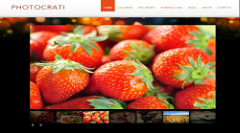Developing A Sound Structure For Your Photography Blog
 When browsing most well put together blogs they all share some very common characteristics, for example at the top of each page or along the sidebar there are categories which allow users to understand the various focuses of the website. Well built blogs also tend to make sure that the content found on the site is the focus, for example a cluttered blog with too many bright colors might distract from the blogs content driven message.
When browsing most well put together blogs they all share some very common characteristics, for example at the top of each page or along the sidebar there are categories which allow users to understand the various focuses of the website. Well built blogs also tend to make sure that the content found on the site is the focus, for example a cluttered blog with too many bright colors might distract from the blogs content driven message.
When creating a photography blog it’s important that a sound structural design is also implemented, a design that allows users to easily find the type of photographs they want while providing easy to view work by the artist will benefit readers and help create a loyal following
In this post we will examine some very simple elements that you can apply when building your first photography blog.
1. Create A Structure That Makes Sense For Your Specific Work
If you’re a photographer who predominantly works with pictures of landscapes there’s a good chance your visitors may be looking for certain types of landscapes such as your work with the Wetlands or the photo selections you offer surrounding harvest time in the Midwest. If those are two types of photo types you offer creating the categories “Wetlands” and “Harvest” might be good options for your website.
It’s important to remember that breaking down your main site categories too far might confuse readers, however under “Wetland” you could offer sub-categories such as “Florida Wetlands” and “Scotland Wetlands” By allowing your visitors to focus in on the types of work you perform they not only find what they enjoy to view faster they also get to understand your specific passions since your site showcases your various focuses in easy to find sections.
In terms of structure you could also choose to break up your work into the types of photographs you take for example black & white, abstract and sepia might all be category options or you might choose to place each of those options as sub-categories under your “wetlands” and “harvest” sections.
I like to think of categories on my personal blogs as a way to show off bits and pieces of my personality to people who care about those same bits and pieces, you can make categories as broad or as shallow as you wish, just make sure those categories provide some type of understanding for your readers.
2. Choose A Background That Doesn’t Distract
Have you ever noticed how many photography blogs use a black or singe colored background? When choosing to build a photography website I find that black and colored backgrounds add finality to a photograph. For example when a noticeable background color surrounds the photo it’s easy for the viewers eyes to be drawn to the photograph and it’s vibrant use of colors or even it’s striking contrasts in black & white photos.
For the reason listed above I suggest using a solid color when developing or choosing a photography blog template, a solid color borders a photo and highlights everything in that photo right up to the photographs edges.
I personally avoid white backgrounds with photography sites since the background “goes on forever” with no definitive border. Think about a photography in a museum or even a painted work of art, they tend to sit inside a frame, a real world border that pushed the viewer the examine what’s inside, in the same sense a strong but none distracting border for a photography blog does the same.
Here’s an example of the Photoland Theme for WordPress, notice how the colorful photos jump out at you because of the simple single colored background:
3. Include What Users Expect To See On Websites
One of the biggest pitfalls a blogger can make when trying to create a website that features photography is to forget the basics of general web design. For example you should add share buttons to your website so users can “Like” your photography on Facebook and Tweet about it on Twitter. When I examine my Facebook and Google+ feeds I tend to see at least three to four photographs being shared by different friends and acquaintances everyday, that’s because “visual” people want to “show” their friends what they have found and a share button allows them to accomplish that goal.
Commenting is also an important aspect that I often see missing from photography blogs. How many times have you been to an art museum where people are discussing what they see before them or explaining the symbolism to other people around them. You don’t necessarily have to engage with your readers through the commenting system if you want to keep your works motive a mystery but you should allow them to engage and discuss your work.
Building a photography blog is like building any other type of blog, you want your users to access your work, share it with friends and interact with it and by creating a structure that makes your work easy to find and then easy to focus on you can create a successful photography blog with very little trouble.



nice article keep it up